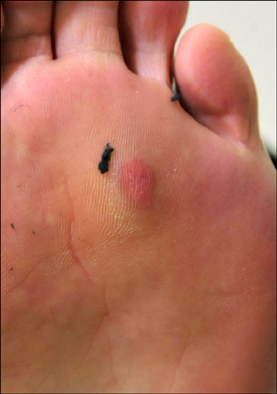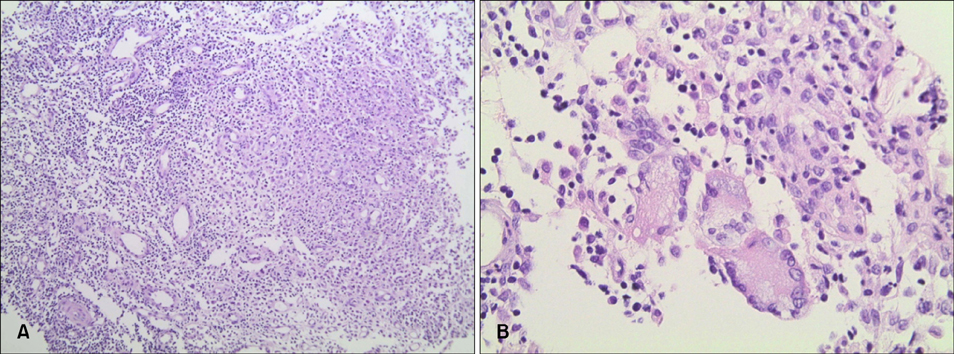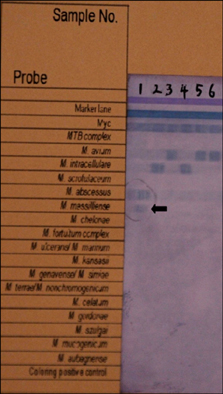Ann Dermatol.
2014 Feb;26(1):92-95. 10.5021/ad.2014.26.1.92.
Cutaneous Mycobacterium massiliense Infection of the Sole of the Feet
- Affiliations
-
- 1Department of Dermatology, Samsung Medical Center, Sungkyunkwan University School of Medicine, Seoul, Korea. dylee@skku.edu
- 2Division of Pulmonary Disease, Department of Internal Medicine, Samsung Medical Center, Sungkyunkwan University School of Medicine, Seoul, Korea.
- 3Department of Laboratory Medicine, Samsung Medical Center, Sungkyunkwan University School of Medicine, Seoul, Korea.
- KMID: 2265703
- DOI: http://doi.org/10.5021/ad.2014.26.1.92
Abstract
- Mycobacterium massiliense which is recognized as a separate species from M. abscessus is little known regarding its clinical patterns and the response to treatment. We present a case of a localized cutaneous infection due to M. massiliense of the sole associated with acupuncture. M. massiliense was identified via polymerase chain reaction-hybridization analysis. We treated the patient with single-drug therapy consisting of clarithromycin for 4 months and the patient showed a significant response to this treatment.
Keyword
Figure
Reference
-
1. Adékambi T, Reynaud-Gaubert M, Greub G, Gevaudan MJ, La Scola B, Raoult D, et al. Amoebal coculture of "Mycobacterium massiliense" sp. nov. from the sputum of a patient with hemoptoic pneumonia. J Clin Microbiol. 2004; 42:5493–5501.2. Koh WJ, Jeon K, Lee NY, Kim BJ, Kook YH, Lee SH, et al. Clinical significance of differentiation of Mycobacterium massiliense from Mycobacterium abscessus. Am J Respir Crit Care Med. 2011; 183:405–410.
Article3. Nakanaga K, Hoshino Y, Era Y, Matsumoto K, Kanazawa Y, Tomita A, et al. Multiple cases of cutaneous Mycobacterium massiliense infection in a "hot spa" in Japan. J Clin Microbiol. 2011; 49:613–617.
Article4. Cho AY, Kim YS, Kook YH, Kim SO, Back SJ, Seo YJ, et al. Identification of cutaneous Mycobacterium massiliense infections associated with repeated surgical procedures. Ann Dermatol. 2010; 22:114–118.
Article5. Kim HY, Yun YJ, Park CG, Lee DH, Cho YK, Park BJ, et al. Outbreak of Mycobacterium massiliense infection associated with intramuscular injections. J Clin Microbiol. 2007; 45:3127–3130.
Article6. Kim BJ, Lee SH, Lyu MA, Kim SJ, Bai GH, Kim SJ, et al. Identification of mycobacterial species by comparative sequence analysis of the RNA polymerase gene (rpoB). J Clin Microbiol. 1999; 37:1714–1720.
Article7. Kim HY, Kook Y, Yun YJ, Park CG, Lee NY, Shim TS, et al. Proportions of Mycobacterium massiliense and Mycobacterium bolletii strains among Korean Mycobacterium chelonae-Mycobacterium abscessus group isolates. J Clin Microbiol. 2008; 46:3384–3390.
Article8. Jogi R, Tyring SK. Therapy of nontuberculous mycobacterial infections. Dermatol Ther. 2004; 17:491–498.
Article
- Full Text Links
- Actions
-
Cited
- CITED
-
- Close
- Share
- Similar articles
-
- Cutaneous Mycobacterium massiliense Infection Associated with Acupuncture
- A Case of Mycobacterium massiliense Infection Presenting as Pneumonia Resistant to Antibiotics in an Immunocompetent Host
- A Case of Skin and Soft Tissue Infection by Mycobacterium massiliense
- Identification of Cutaneous Mycobacterium massiliense Infections Associated with Repeated Surgical Procedures
- Case of Mycobacterium Massiliense Infection Presenting as Recurrent Pneumonia in Sjogren's Syndrome





